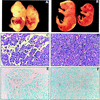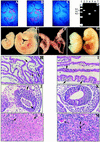K-ras is an essential gene in the mouse with partial functional overlap with N-ras
- PMID: 9334313
- PMCID: PMC316567
- DOI: 10.1101/gad.11.19.2468
K-ras is an essential gene in the mouse with partial functional overlap with N-ras
Erratum in
- Genes Dev 1997 Dec 1;11(23):3277
Abstract
Mammalian ras genes are thought to be critical in the regulation of cellular proliferation and differentiation and are mutated in approximately 30% of all human tumors. However, N-ras and H-ras are nonessential for mouse development. To characterize the normal role of K-ras in growth and development, we have mutated it by gene targeting in the mouse. On an inbred genetic background, embryos homozygous for this mutation die between 12 and 14 days of gestation, with fetal liver defects and evidence of anemia. Thus, K-ras is the only member of the ras gene family essential for mouse embryogenesis. We have also investigated the effect of multiple mutations within the ras gene family. Most animals lacking N-ras function and heterozygous for the K-ras mutation exhibit abnormal hematopoietic development and die between days 10 and 12 of embryogenesis. Thus, partial functional overlap appears to occur within the ras gene family, but K-ras provides a unique and essential function.
Figures





 ; 11%–25%
; 11%–25%  ; 26%–50% ; 51%–75%
; 26%–50% ; 51%–75%  ; or 76%–100%
; or 76%–100%  . (ND) Not determined. K-ras−/− ES cells had significantly reduced contribution to multiple hematopoietic lineages and the tissues that support their production throughout embryogenesis and adulthood.
. (ND) Not determined. K-ras−/− ES cells had significantly reduced contribution to multiple hematopoietic lineages and the tissues that support their production throughout embryogenesis and adulthood.

Similar articles
-
Targeted genomic disruption of H-ras and N-ras, individually or in combination, reveals the dispensability of both loci for mouse growth and development.Mol Cell Biol. 2001 Mar;21(5):1444-52. doi: 10.1128/MCB.21.5.1444-1452.2001. Mol Cell Biol. 2001. PMID: 11238881 Free PMC article.
-
Transcription elongation factor S-II is required for definitive hematopoiesis.Mol Cell Biol. 2006 Apr;26(8):3194-203. doi: 10.1128/MCB.26.8.3194-3203.2006. Mol Cell Biol. 2006. PMID: 16581793 Free PMC article.
-
Hlx homeo box gene is essential for an inductive tissue interaction that drives expansion of embryonic liver and gut.Genes Dev. 1996 Jan 1;10(1):70-9. doi: 10.1101/gad.10.1.70. Genes Dev. 1996. PMID: 8557196
-
Mouse models in the study of the Ets family of transcription factors.Oncogene. 2000 Dec 18;19(55):6443-54. doi: 10.1038/sj.onc.1204038. Oncogene. 2000. PMID: 11175360 Review.
-
Functional consequences of integrin gene mutations in mice.Circ Res. 2001 Aug 3;89(3):211-23. doi: 10.1161/hh1501.094874. Circ Res. 2001. PMID: 11485971 Review.
Cited by
-
Characteristics of lung cancers harboring NRAS mutations.Clin Cancer Res. 2013 May 1;19(9):2584-91. doi: 10.1158/1078-0432.CCR-12-3173. Epub 2013 Mar 20. Clin Cancer Res. 2013. PMID: 23515407 Free PMC article.
-
K-Ras4A splice variant is widely expressed in cancer and uses a hybrid membrane-targeting motif.Proc Natl Acad Sci U S A. 2015 Jan 20;112(3):779-84. doi: 10.1073/pnas.1412811112. Epub 2015 Jan 5. Proc Natl Acad Sci U S A. 2015. PMID: 25561545 Free PMC article.
-
PGA1-induced apoptosis involves specific activation of H-Ras and N-Ras in cellular endomembranes.Cell Death Dis. 2016 Jul 28;7(7):e2311. doi: 10.1038/cddis.2016.219. Cell Death Dis. 2016. PMID: 27468687 Free PMC article.
-
Expression profile of critical genes involved in FGF signaling pathway in the developing human primary dentition.Histochem Cell Biol. 2015 Nov;144(5):457-69. doi: 10.1007/s00418-015-1358-7. Epub 2015 Aug 13. Histochem Cell Biol. 2015. PMID: 26266341
-
What's new in the neuro-cardio-facial-cutaneous syndromes?Eur J Pediatr. 2007 Nov;166(11):1091-8. doi: 10.1007/s00431-007-0535-7. Epub 2007 Jul 5. Eur J Pediatr. 2007. PMID: 17611774 Review.
References
-
- Barbacid M. ras genes. Annu Rev Biochem. 1987;56:779–827. - PubMed
-
- Bos JL. The ras gene family and human carcinogenesis. Mutat Res. 1988;195:255–271. - PubMed
-
- ————— ras oncogenes in human cancer: A review [published erratum appears in Cancer Res 1990 Feb 15; 50 (4): 1352] Cancer Res. 1989;49:4682–4689. - PubMed
-
- Bourne HR, Sanders DA, McCormick F. The GTPase superfamily: A conserved switch for diverse cell functions. Nature. 1990;348:125–132. - PubMed
-
- Bradley A. Production and analysis of Chimeric mice. In: Robertson EJ, editor. Teratocarcinomas and embryonic stem cells: A practical approach. Oxford, UK: IRL Press; 1987. pp. 113–152.
Publication types
MeSH terms
LinkOut - more resources
Full Text Sources
Other Literature Sources
Molecular Biology Databases
Research Materials
Miscellaneous
